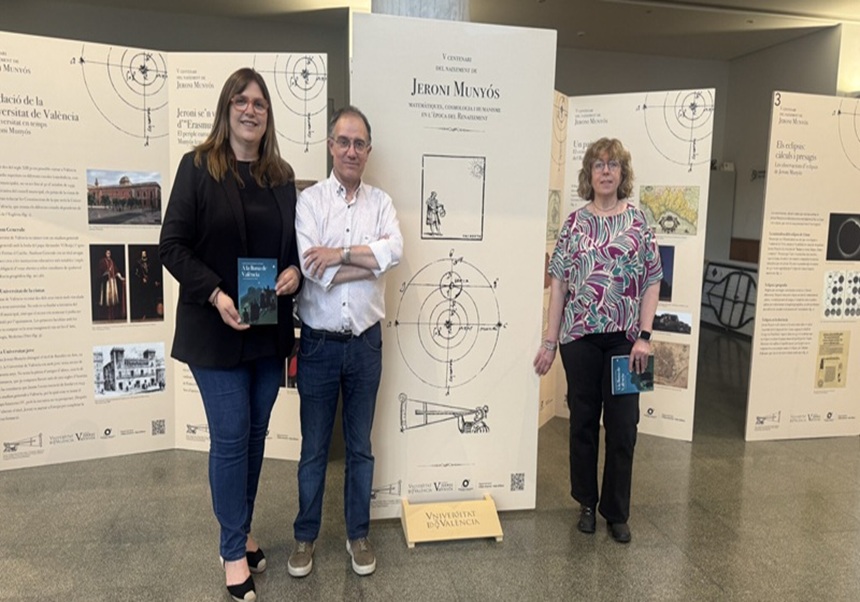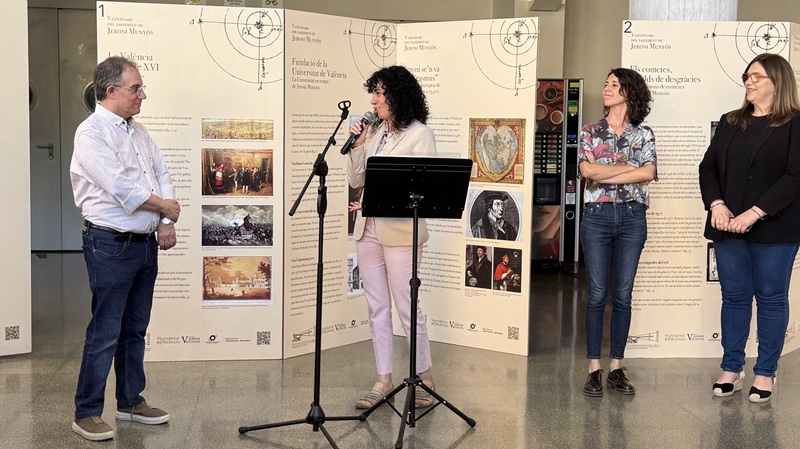
On Wednesday, May 28, the exhibition 'Jeroni Munyós: Mathematics, Cosmology and Humanism in the Renaissance' will be inaugurated at the Casa de la Cultura in Tavernes."
On Wednesday, May 28, the exhibition “Jeroni Munyós: Mathematics, Cosmology and Humanism in the Renaissance” was inaugurated at the Casa de la Cultura in Tavernes. The exhibition aims to shed light on the life and work of one of the most prominent figures in Valencian science during the Renaissance. It will be open to visitors every morning and evening when events are held at the Casa de la Cultura until June 26.
The opening ceremony featured speeches by Councillor for Culture, Encar Mifsud, Carme Melo, Director of the International Centre of Gandia of the University of Valencia (UV), and Mayor Lara Romero. Also in attendance were the General Manager of the UV, Juan Vicente Climent, members of the local government, and colleagues from the university.
In addition to introducing the exhibition, the speeches emphasized the historical significance of Jeroni Munyós, and especially the UV–Town Council collaboration, which made it possible to bring the exhibition to Tavernes after its tour through several towns and university centers. It was also announced that there are plans to continue this collaboration, with a second exhibition from the University of Valencia already in the works.
The event also served to present the collective book “A la lluna de València. 10 biografies d’astrònom a astrònom” ("Under the Moon of Valencia: 10 Biographies from Astronomer to Astronomer"), which offers insight into Valencian scientific history through the biographies of its most notable astronomers.
Jeroni Munyós and the Supernova of 1572
Next, Enric Marco, from the Department of Astronomy and Astrophysics at the University of Valencia, gave a talk titled “Jeroni Munyós and the Supernova of 1572.” Carmen Melo introduced the speaker, highlighting his role in the Astronomy Department and his various research projects related to urban night lighting and light pollution.
In the lecture, Marco explained how Jeroni Munyós's observation and study of the new star that appeared in the sky over Valencia in early November 1572 led him to reject the idea of the incorruptibility of the heavens and the immutability of celestial bodies. This contributed to the shift from the geocentric model to the heliocentric model, aligning Munyós with other European scientists of the time such as Tycho Brahe, Copernicus, and Galileo Galilei.
After the talk, Marco answered questions from the audience and explained some details about supernovae from the perspective of modern science, including the life cycles of stars, and mentioned that the Sun, a medium-sized star, is currently halfway through its life. It has about 4.5 billion years left in a stable phase before entering an expansion stage in which Earth will likely be destroyed.
The Exhibition
The exhibition, on display in the lobby of the Casa de la Cultura until June 26, is a joint project by the Astronomical Observatory and the Department of Astronomy and Astrophysics, featuring texts about the most relevant aspects of Jeroni Munyós’s life and work. The content was prepared by Amelia Ortiz Gil and Fernando Ballesteros Roselló from the Observatory, and Enric Marco Soler from the Department of Astronomy and Astrophysics—all from the University of Valencia.
The exhibition traces Munyós’s life from his birth in Valencia in 1522 to his death in Valladolid in 1591, including details about his youth during a turbulent period marked by the Germanies revolt and the subsequent repression led by Viceroy Germana de Foix.
The panels explore his career as a professor at the University of Valencia, where he carried out multiple roles beyond teaching mathematics, Hebrew, and astronomy. He worked on astronomy, mathematics, geodesy, border delimitation between the Kingdom of Valencia and Castile, a census of the Valencian population (both Christian and Morisco), geography treatises, and engineering projects to channel water to Valencia, Murcia, Lorca, Cartagena, Salamanca, among others. However, what brought him fame across the Hispanic kingdoms and Europe was his observation and study of the new star that appeared over Valencia in November 1572.
Images:











